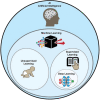Deep Learning in Neuroradiology
- PMID: 29419402
- PMCID: PMC7410723
- DOI: 10.3174/ajnr.A5543
Deep Learning in Neuroradiology
Abstract
Deep learning is a form of machine learning using a convolutional neural network architecture that shows tremendous promise for imaging applications. It is increasingly being adapted from its original demonstration in computer vision applications to medical imaging. Because of the high volume and wealth of multimodal imaging information acquired in typical studies, neuroradiology is poised to be an early adopter of deep learning. Compelling deep learning research applications have been demonstrated, and their use is likely to grow rapidly. This review article describes the reasons, outlines the basic methods used to train and test deep learning models, and presents a brief overview of current and potential clinical applications with an emphasis on how they are likely to change future neuroradiology practice. Facility with these methods among neuroimaging researchers and clinicians will be important to channel and harness the vast potential of this new method.
© 2018 by American Journal of Neuroradiology.
Figures






References
-
- Krizhevsky A, Sutskever I, Hinton G. ImageNet classification with deep convolutional neural networks. http://www.cs.toronto.edu/~fritz/absps/imagenet.pdf. Accessed January 23, 2018.
Publication types
MeSH terms
LinkOut - more resources
Full Text Sources
Other Literature Sources
